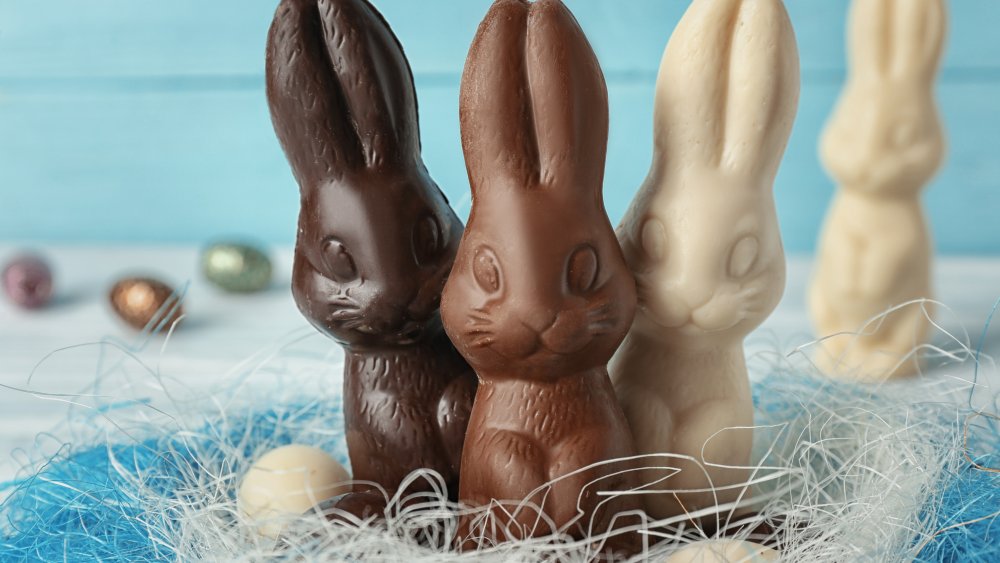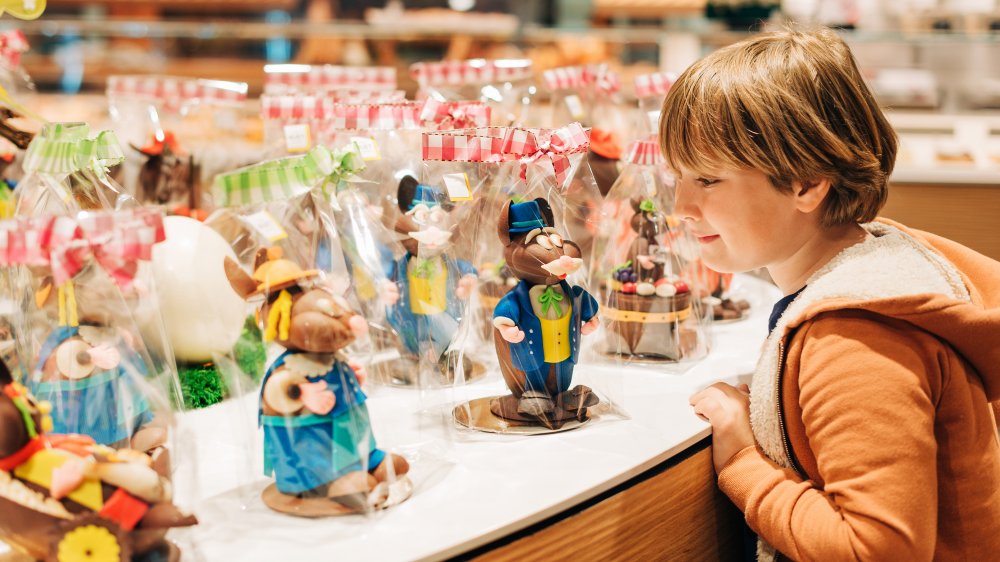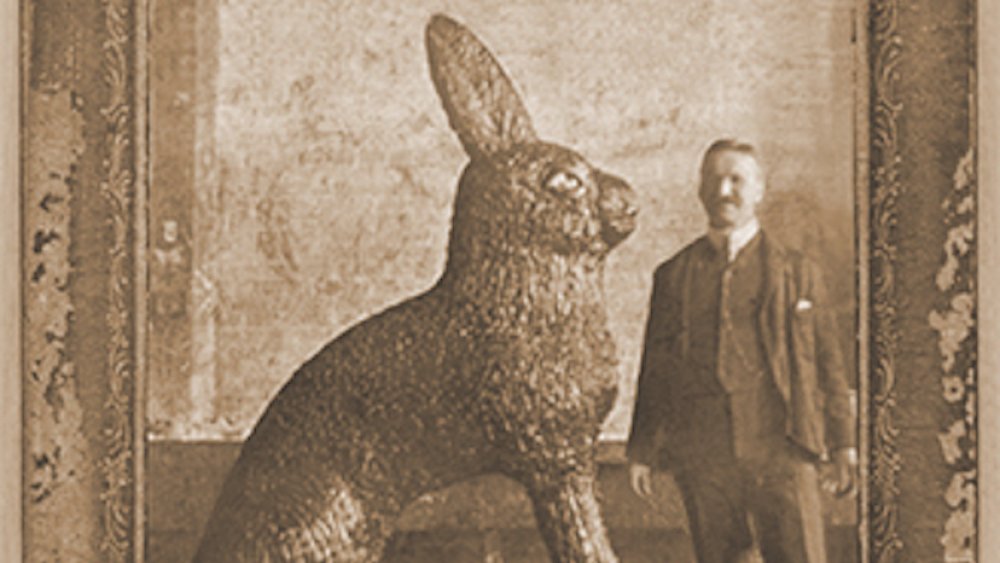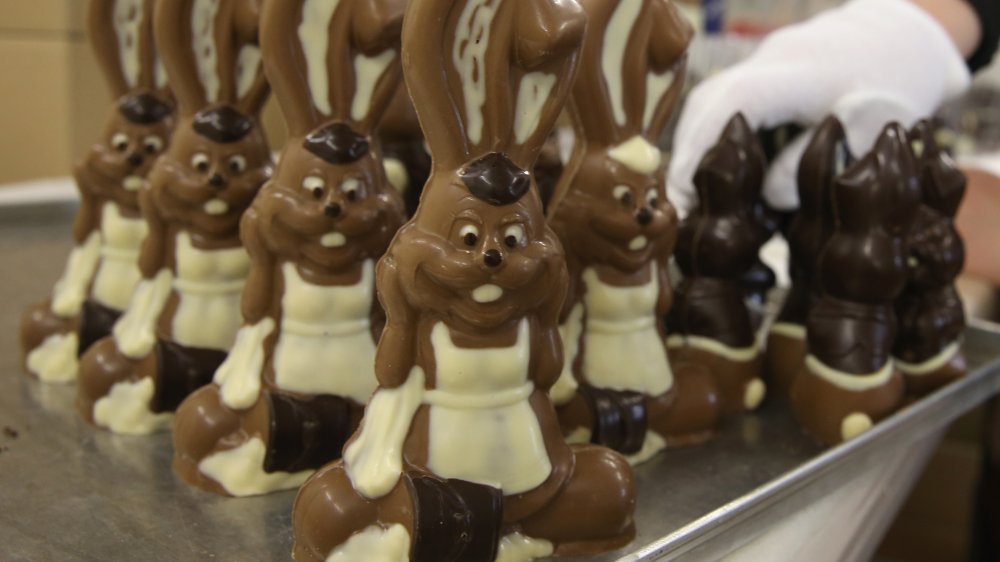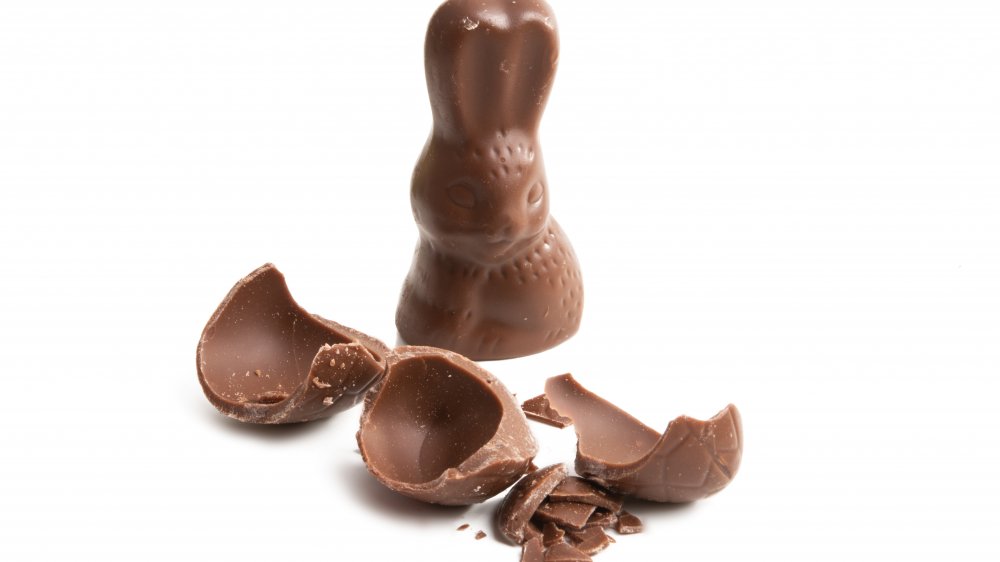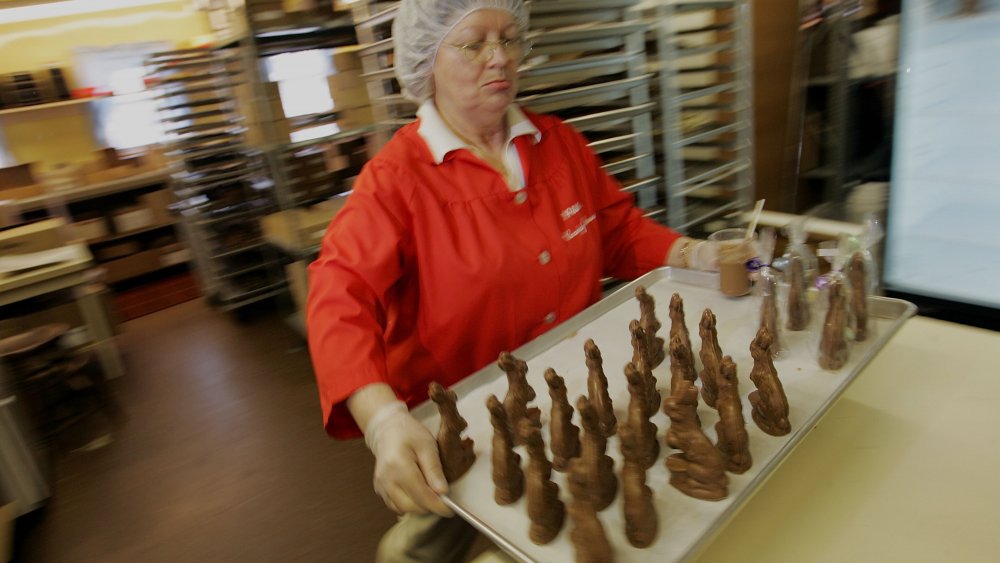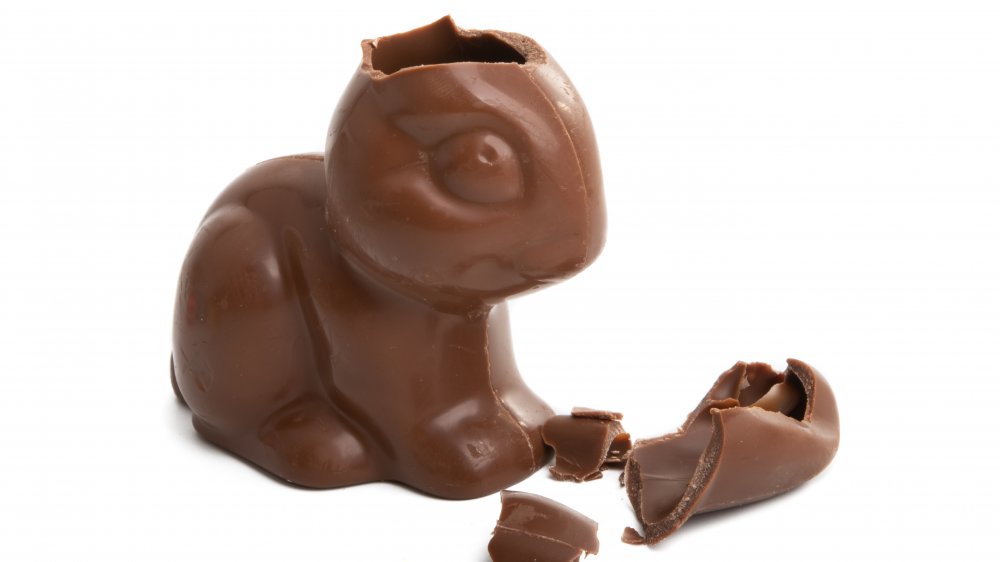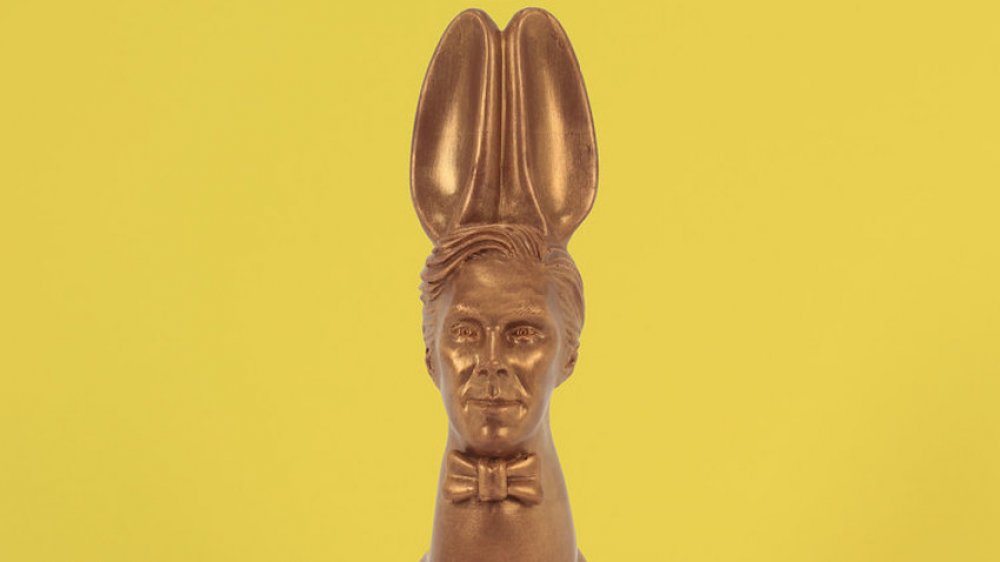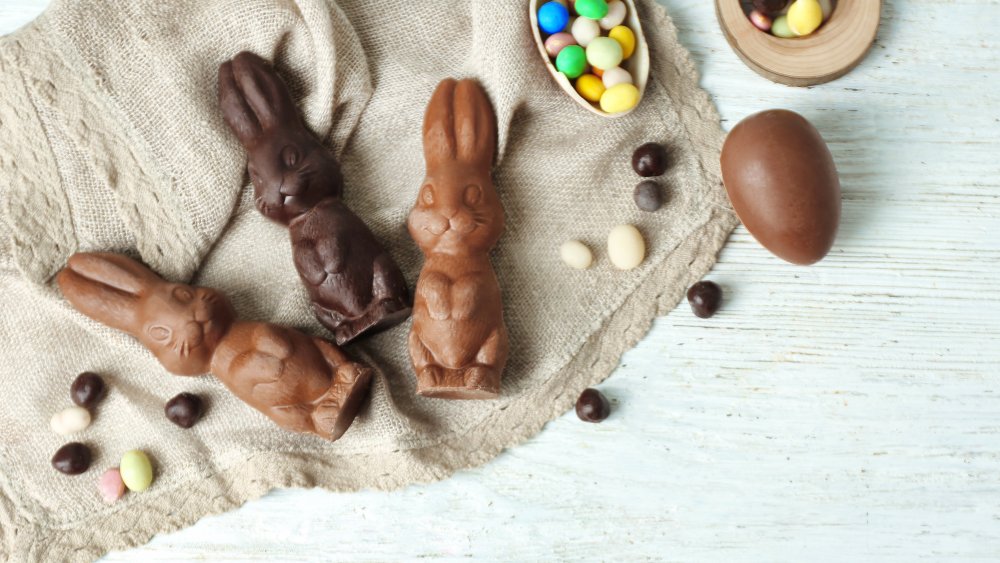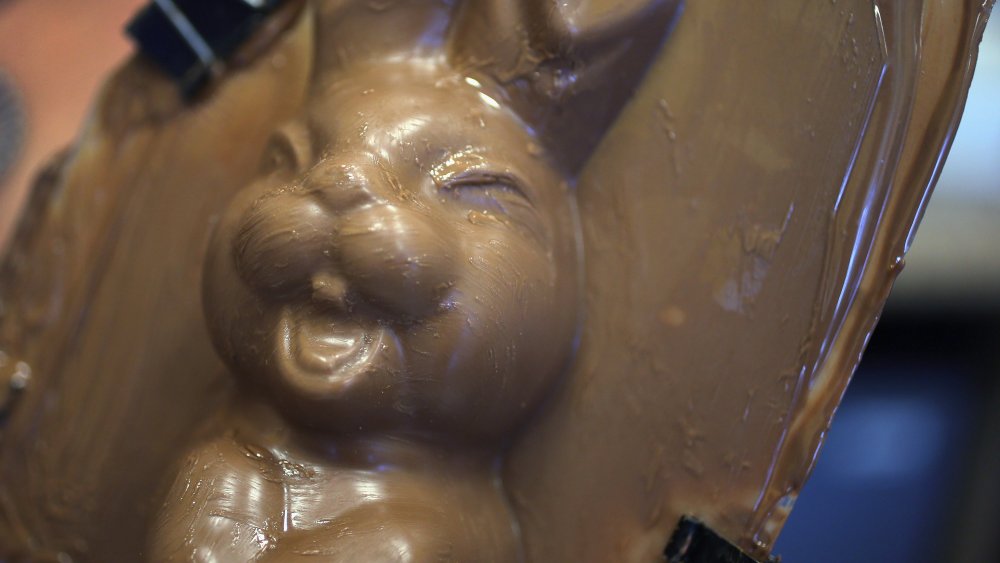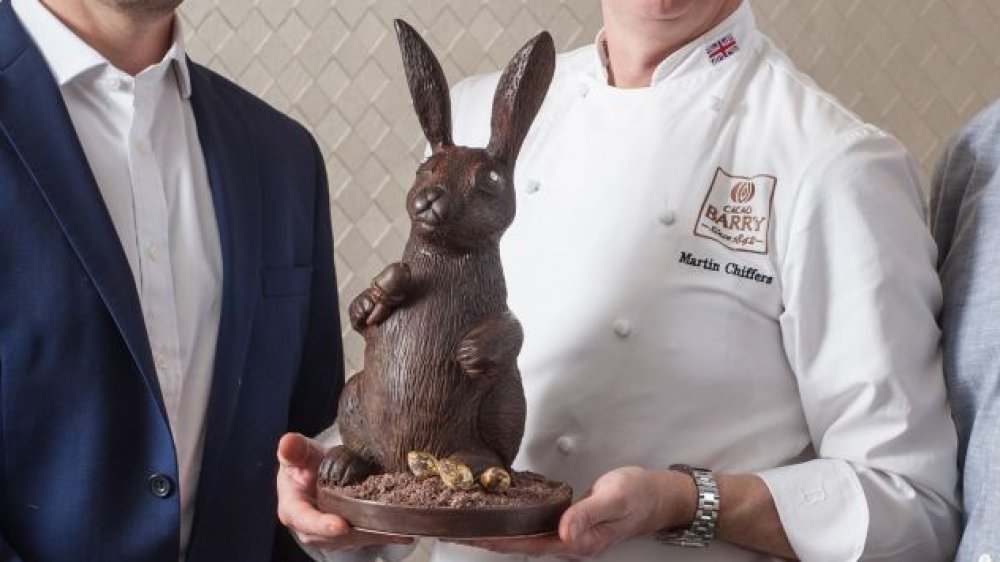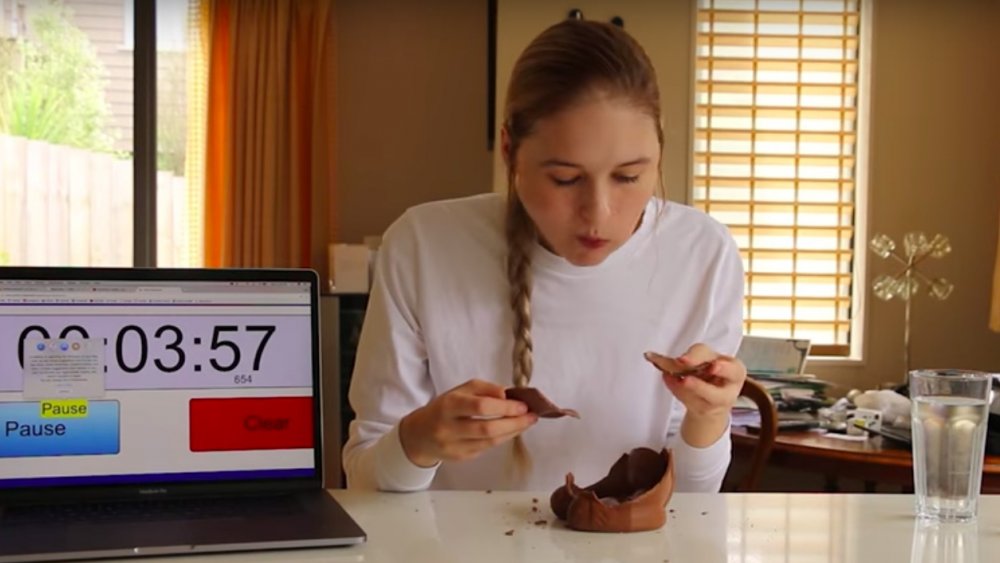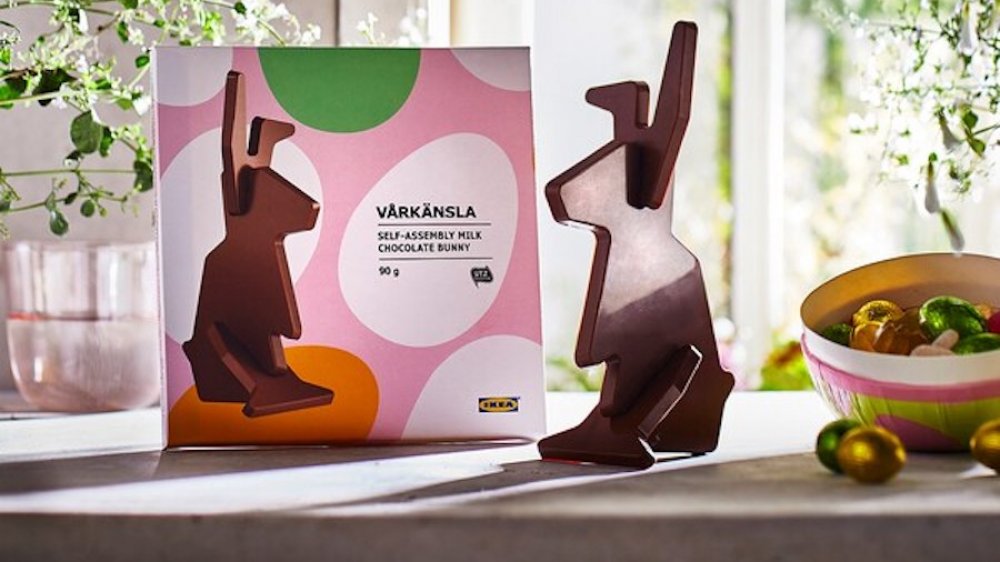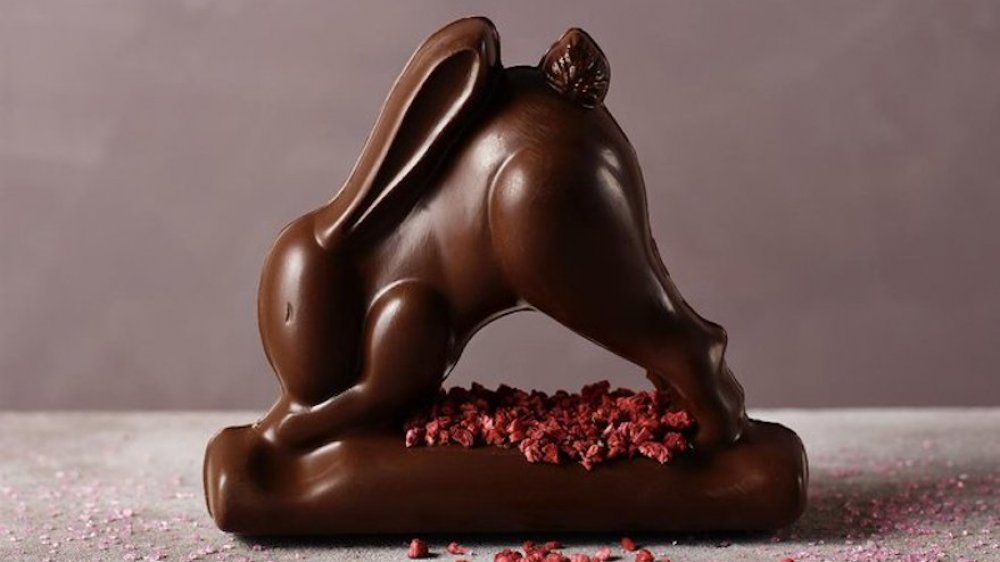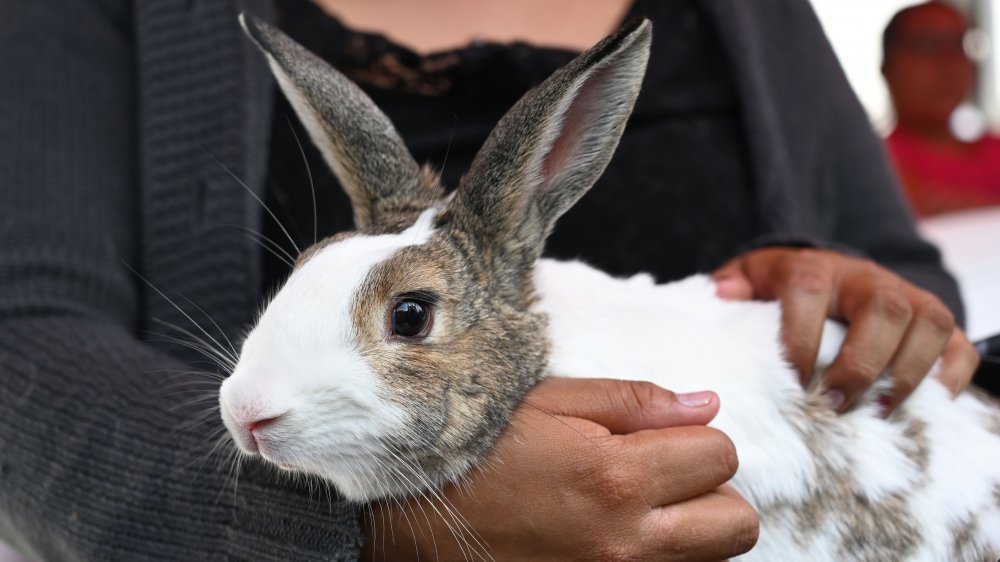The Untold Truth Of Chocolate Easter Bunnies
Each spring, Easter baskets throughout the world are stuffed with treats, and certain to be among them are chocolate bunnies. These springtime delights have hopped their way into millions of hearts — not to mention stomachs — to become a springtime staple associated with the holy Christian holiday celebrating the resurrection of Christ.
According to History.com, the Easter bunny's origins in the U.S. can likely be traced back to the 1700s, when German settlers brought with them an ancient tradition involving a magical hare — called "Osterhase" or "Oschter Haws" — that laid colorful eggs. Children were encouraged to make nests, into which the hare would lay its eggs. Children would also leave carrots out (much like the milk and cookies offered to Santa) in case the hare became hungry from all that hopping and egg-laying.
That tradition ultimately evolved to include the now-ubiquitous chocolate bunnies, an annual treat beloved by millions. How that evolution took place, however, is a fascinating story full of twists and turns. Read on to discover the untold truth of chocolate Easter bunnies.
Chocolate Easter bunnies have pagan roots
While chocolate bunnies have come to be associated with a key event in Christianity, the treats have nothing to do with religion. In fact, the reason behind rabbits' association with Easter actually predates the religion. In fact, bunnies symbolized the coming of spring long before the time of Christ.
"Rabbits (originally hares) are longstanding fertility symbols associated with the arrival of spring, because they are so prolific and give birth as soon as the weather warms," Rutgers University religion professor Dr. Diane Shane Fruchtman told Reader's Digest.
And while Easter celebrates Christ's resurrection after being crucified, parts of this holy holiday stem from pagan worship, not Christianity. In fact, the term "Easter" is believed to be derived from Ostara, a pagan goddess once worshipped by Germanic people (the Anglo-Saxons worshipped a similar deity with a similar name, Eostre). Her sacred animal, in fact, was the rabbit.
Before Easter was celebrated by Christians, pagans worshipped Ostara/Eostre with an annual celebration heralding the arrival of the spring equinox. The holiday — and its name — remained, but adopted a whole new meaning taken from Christianity. Some of the original trappings of the ancient pagan festival, such as rabbits and eggs (symbolizing spring's rebirth), are still associated with Easter.
The father of Easter's chocolate bunny
Chocolate Easter bunnies as we know them today became popularized throughout the U.S. in 1890 thanks to Pennsylvania shop owner Robert L. Strohecker. As Slate points out, a 2003 chocolate-themed exhibit at the Museum of Natural History identified Strohecker as "the 'father' of the chocolate Easter bunny," who kicked off the chocolate bunny craze when he began selling them at his drugstore.
To promote his rabbits, Strohecker displayed a five-foot tall chocolate bunny in the window of his drugstore in Reading, Pennsylvania. According to Harbor Sweets — a chocolate manufacturing company founded by Strohecker's grandson, Ben Strohecker — the giant bunny was made in the Pennsylvania factory of candy manufacturer William H. Luden, who would go on to make his fortune by inventing the menthol cough drop. After that, sales of chocolate Easter bunnies started to take off.
A New York Times profile on Ben Strohecker and his business practices revealed that a photo of his grandfather, standing next to his prized giant-sized chocolate bunny, had been hanging on a wall in Harbor Sweets for years. The photo and Strohecker's familial association with chocolate Easter bunnies eventually led the company to create its own signature bunnies, the Robert L. Strohecker Assorted Rabbit collection.
Chocolate Easter bunny personalities were introduced in 1934
While chocolate Easter bunnies first started to become a popular Easter treat in the 1890s, there wasn't anything particularly distinctive about them. It wasn't until the 1930s, in fact, that chocolate bunnies first started to have "personalities," engaging in various activities and taking on a more cartoon-like appearance.
According to The New York Times, the Bortz Chocolate Company in Reading, Pennsylvania, was one of the first candy-makers to undertake large-scale production of chocolate bunnies. The advent of automation in factories during this period, noted Entrepreneur, allowed the company to take some risks and get a little creative with their bunnies. In 1934, this led Bortz to introduce the first "personality" rabbits, including one that played an accordion and another that drove a car.
While cute bunnies doing cute stuff remain popular with consumers, the same is true of the more traditional chocolate rabbit. In fact, the tried-and-true chocolate bunny of yesteryear isn't going anywhere. ”There are bunnies today that ski, go to the beach and play video games,” Wayne Stottmeister, vice president of sales and marketing for Bortz, told the Times in 1989. ”But the traditional rabbit is here to stay." That still rings pretty true today.
Here's why most chocolate Easter bunnies are hollow
While an article in the The New York Times exploring the lore and legends of the chocolate Easter bunny may have joked that biting into a hollow bunny is "a child's first taste of deception," it's easy to assume that chocolate manufacturers make their bunnies with hollow centers as a cost-cutting measure. And while a hollow bunny will indeed include less chocolate than a solid one, there's actually another reason behind hollow chocolate bunnies.
"If you had a larger-size bunny and it was solid chocolate, it would be like a brick; you'd be breaking teeth," Mark Schlott, vice-president of operations at R.M. Palmer in Reading, Pennsylvania, told Smithsonian Magazine in 2010.
Working with a company identified as "one of the first and largest manufacturers of hollow chocolate bunnies," Schlott is something of an expert on the subject, and did concede that hollow bunnies are a less-expensive alternative to the solid versions. Discussing the financial advantages of hollow bunnies vs. solid ones, Schlott explained that a hollow bunny "has a greater perceived value. It creates a much greater chocolate footprint than solid."
A lot of chocolate Easter bunnies are sold each year
It's no secret that chocolate Easter bunnies are popular with consumers, but the numbers tell the real story when it comes to just how popular they are. Utilizing statistics provided by the National Confectioners Association, The Street reported in 2017 that a whopping 90 million chocolate bunnies were expected to be sold in the United States that year.
The report also noted that the Easter holiday in and of itself was responsible for generating an estimated $18.4 billion in spending for that year within the U.S. The report estimated that 120 million pounds of Easter candy is purchased in the U.S. each year, with chocolate bunnies representing a substantial portion of all that sweet spending. In fact, chocolate is far and away the most popular Easter candy, with 90 percent of parents typically putting some sort of chocolate treat in their kids' Easter baskets.
Back in 2012, ABC News pointed out that $2.1 billion was spent on candy alone each Easter — and of all that candy, 70 percent of it was chocolate.
Most people eat a chocolate Easter bunny's ears first
Eating a chocolate Easter bunny is something of a ritual, and most people have a very specific way of doing it. According to Science Daily, a study that surveyed more than 28,000 respondents revealed that an overwhelming majority of people start with the ears. In fact, a full 59 percent of people who enjoy chocolate Easter bunnies start with the ears, while 33 percent of respondents claimed to have no preference. A mere four percent, however, said they preferred to eat a chocolate bunny by starting with the feet or tail.
A tongue-in-cheek study published in medical journal The Laryngoscope examined the "seasonality or auricular amputations" in chocolate bunnies, concluding that there appeared to be a "statistically significant increase in mention of rabbit auricular amputations" in the spring, with "annual peak incidence" of these chocolate bunny amputations "to be near Easter." The report also noted that "human adults and children appear to be wholly responsible" for all those bunny-ear amputations.
"It was interesting to discover that few other confectionary symbols, such as Santa, succumb to isolated defects, like the chocolate bunnies do," explained Dr. Kathleen Yaremchuk, lead author of the Laryngoscope study.
There have been some VERY weird chocolate Easter bunnies
While chocolate bunnies depicted as playing the accordion and driving automobiles were pretty avant garde when they debuted in the 1930s, modern-day bunnies have tended to push the envelope even further. One of the more gruesome is the green, bloody zombie bunny, which "may or may not infect you with a zombie virus." Meanwhile, fans of actor Benedict Cumberbatch can start off Easter morning with the "Chocolate Cumberbunny" — which is even available in a limited edition with "an edible 22 carat gold bow-tie."
Even weirder, St. Louis chocolatier "Candy" Andy Karandzieff has gained fame for creating "misfit" chocolate bunnies out of broken bunny pieces, combining these misshapen chunks into what Today described as "freakishly delicious works of art." Among the creations detailed were a chocolate rabbit with a doll's head, another with two heads — on of those where it belong, and the other in a basket.
"I thought maybe I could do something a little more creative with these, so I started gluing different heads on different bodies," Karandzieff told Today, admitting he enjoys being able to inject a little subversion into Easter baskets. "Nothing says 'happy Easter' like a creepy doll head in your kids' Easter basket!"
Your chocolate Easter bunny might not be made out of chocolate
Is that chocolate bunny in the Easter basket actually made out of chocolate? That's a question tackled by Cooking Light, which pointed out that what consumers assume to be chocolate might actually be "a mix of sugar, oils and emulsifiers masquerading as such."
As pastry chef Shelly Toombs told the website, Easter bunnies are typically made from one of two types of chocolate, one of which isn't technically even chocolate. The way to determine whether a chocolate bunny is legit is simply to check the label to determine the percentage of chocolate. What consumers need to look for is couverture chocolate, she said, a higher-quality chocolate derived from cacao beans. According to Toombs, "the higher the percentage, the less sweet it's going to be, and the more intense flavor you're going to get."
The stuff to avoid is a lower-quality chocolate with a low chocolate content, known as "compound chocolate," which, unfortunately, is what a lot of mass-produced candy is made from. This, explained Toombs, "is basically a combination of vegetable fats and sweeteners. Some brands will use these along with emulsifiers, because they're low-cost ingredients, compared to using cocoa butter."
The world's largest chocolate Easter bunny weighed 8,000 pounds
When it comes to sheer size, one chocolate Easter bunny stands head and shoulders — and then some — above the rest. According to the Guinness Book of World Records, in 2014 a Brazilian company called Senac-RS celebrated the city of Gramado's annual Chocofest by constructing a mammoth 8,488-pound chocolate bunny that was officially declared the world's largest.
It reportedly took a nine-person team five days to construct the bunny, using 6,000 large bars of chocolate that were "set like bricks." Melted chocolate was used as a type of mortar, essentially mimicking the same process that would be used to build a brick wall. A professional engineer was brought in to "ensure the stability" of the towering bunny, with a sculptor then using an axe and chisel to create the bombastic bunny's final design.
After staying on display for a week, when Chocofest concluded the rabbit was deconstructed. As for the chocolate itself, it was later donated to Mesa Brasil, a nationwide organization that distributes food to the needy throughout the country.
The world's most expensive chocolate Easter bunny cost $49K
Big spenders looking to drop some serious coin at Easter should take note of an opulent chocolate bunny with a five-figure price tag, reported to be the most expensive ever created.
As Huffpost shared back in 2015, the bunny was produced by now-defunct luxury retailer VeryFirstTo, and had a jaw-dropping $49,000 price tag. The life-sized chocolate bunny weighed 11 pounds, and was made from Tanzania origin chocolate. To create the costly confection, renowned pastry chef Martin Chiffers (former chef decor with London's famed Harrods department store) hand-carved the chocolate over a two-day period. As for the bunny's extravagant expense, chalk that up to its glittering eyes, made from massive diamonds said to be worth $37,400, while a trio of chocolate eggs at the bunny's feat were decorated with gold leaf.
"The project was challenging in every aspect. But for me it was mostly about getting the right shape and doing the carving well to achieve perfection," Chiffers admitted in an interview with Cacao Barry, adding that he sought "perfection in the shapes and structures which would play nicely with the precious diamonds."
A competitive eater consumed a 1.25-lb chocolate Easter bunny in under 10 minutes
Most people see a chocolate Easter bunny as a yummy treat to be enjoyed at their leisure. A competitive eater, however, will see the bunny as a challenge to be met. That was the case when Wolfgang Confectioners of York, Pennsylvania, held its Chocolate Bunny Challenge, in which each competitor attempted to consume a 1.25-pound chocolate bunny as quickly as humanly possible.
In 2015, reported Flipside PA, Steve Hillegass set a record by inhaling the entire chocolate bunny in seven minutes and 57 seconds. The following year, former champion Don Yeager regained his title when he chowed down his entire bunny in nine minutes and 30 seconds. For anyone contemplating entering the competitive chocolate bunny-eating game, the pros insist the best way to get it done it to first crush the bunny and then eat the small pieces — a far faster method than gnawing away at it in one piece.
Meanwhile, both Hillegass and Yeager had better watch their backs. In 2017, Nela Zisser posted a video on YouTube in which she scarfed down an entire chocolate bunny in a mere seven minutes. While she didn't specify the bunny's weight, it looked plenty big!
IKEA sells a flat-packed chocolate Easter bunny
For those who enjoy the faux carpentry involved in putting together IKEA furniture, the Swedish home decor retailer unveiled its own version of a chocolate Easter bunny in 2019. Like its iconic bookcases and end tables, IKEA's chocolate bunny is packed flat and must be unpacked and then assembled by hand.
"Go ahead, play with your food!" reads IKEA's description of its Varkansla chocolate bunny. "That's what this certified sustainable chocolate bunny is for. It's easily assembled, only three parts. And when finished playing, we bet you'll enjoy eating it, too."
As Boston 25 News pointed out, Varkansla translates to "spring feeling," which is certainly the vibe one would experience when constructing a flat-pack chocolate bunny. With only three pieces to assemble, the chocolate bunny — which is made from UTZ-certified cacao and contains a minimum of 30 percent cocoa — is reportedly a breeze to put together. The best part: unlike most of IKEA's furniture, there's no Allen key required when assembling the chocolate Easter bunny.
A chocolate yoga bunny cooked up controversy on Easter
In 2019, iconic British retailer Marks & Spencer introduced its own clever take on a chocolate Easter bunny, gearing its bunny toward yoga aficionados. As a result, the Marks & Spencer Yoga Bunny is depicted in the yoga pose known as the "downward dog," in which the hands and feet are on the ground while one's posterior is pushed as high in the air as possible.
As Ireland's Extra reported, controversy ensued when the company posted a photo of its Yoga Bunny on Twitter, writing, "Hop to it and try this cheeky Easter treat for yourself in store now."
One cheeky Twitter user said the Yoga Bunny "is very 'door's on the latch, find me upstairs,'" while another joked that "#JessicaRabbit's gone a bit suggestive for #Easter." Marks & Spencer responded, tweeting, "Suggestive? It's merely a bunny in the 'downwards-facing dog' yoga position, Christian!"
The SPCA encourages eating chocolate Easter bunnies
The Society for the Protection of Cruelty to Animals, commonly known as the SPCA, launched a campaign in Canada encouraging people to chow down on chocolate bunnies for Easter instead of buying actual bunnies as pets.
As CBC News reported in 2018, the Montreal SPCA receives hundreds of abandoned rabbits each year when the novelty wears off and the reality sets in that looking after a rabbit actually requires a lot of time and effort. With a rabbit's lifespan averaging 12 years, owning one is a major commitment that extends far beyond the Easter weekend.
"The animals turned in to SPCA shelters are the fortunate ones," explained Lorie Chortyk of the British Columbia SPCA. "Many others are simply abandoned in the wild to fend for themselves, and these domesticated rabbits often fall prey to predators such as coyotes, are susceptible to disease, or end up starving to death." On the flip side, the BC SPCA's website pointed out, if rabbits are abandoned and manage to survive, a whole other problem can arise when rabbit overpopulation takes place, upsetting the delicate balance of nature.
Bottom line: the best bunnies to enjoy at Easter are the chocolate ones.
